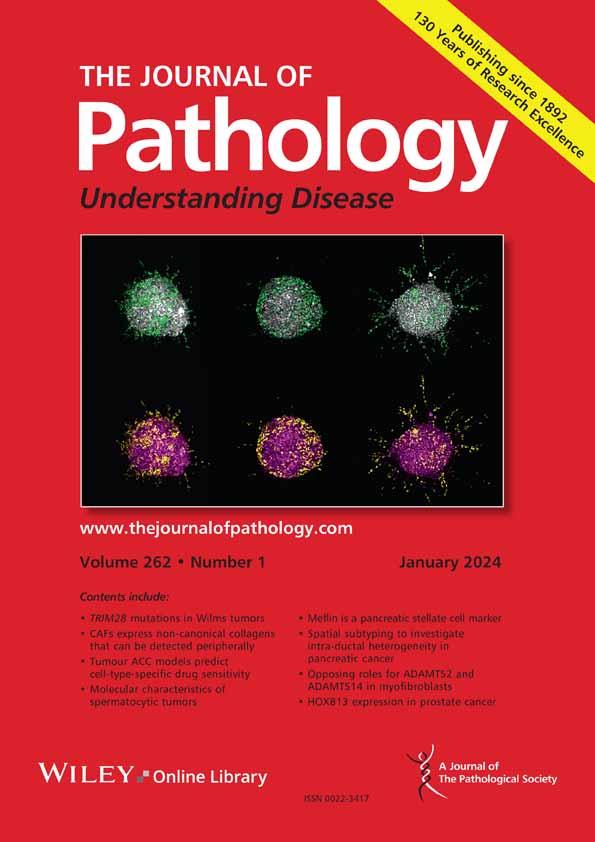Nicola S Meagher, Martin Köbel, Anthony N Karnezis, Aline Talhouk, Michael S Anglesio, Andrew Berchuck, Simon A Gayther, Paul PD Pharoah, Penelope M Webb, Susan J Ramus, Kylie L Gorringe
下载PDF
{"title":"Cellular origins of mucinous ovarian carcinoma","authors":"Nicola S Meagher, Martin Köbel, Anthony N Karnezis, Aline Talhouk, Michael S Anglesio, Andrew Berchuck, Simon A Gayther, Paul PD Pharoah, Penelope M Webb, Susan J Ramus, Kylie L Gorringe","doi":"10.1002/path.6407","DOIUrl":null,"url":null,"abstract":"<p>Mucinous ovarian carcinoma (MOC) is a rare histotype of epithelial ovarian cancer. Its origins are obscure: while many mucinous tumours in the ovary are metastases from the gastrointestinal tract, MOC can occur as an ovarian primary; however, the cell of origin is not well established. In this review we summarise the pathological, epidemiological, and molecular evidence for the cellular origins of MOC. We propose a model for the origins of the various tumours of the ovary with mucinous differentiation. We distinguish Müllerian from gastrointestinal-type mucinous differentiation. A small proportion of the latter arise from teratoma and a distinct terminology has been proposed. Other gastrointestinal mucinous tumours are associated with Brenner tumours and arise from their associated benign lesions, Walthard nests. The remaining mucinous tumours develop either through mucinous metaplasia in established Müllerian tumours or with even greater plasticity through gastrointestinal metaplasia of epithelial or mesothelial ovarian inclusions. This model remains to be validated and mechanistically understood and we discuss future research directions. © 2025 The Author(s). <i>The Journal of Pathology</i> published by John Wiley & Sons Ltd on behalf of The Pathological Society of Great Britain and Ireland.</p>","PeriodicalId":232,"journal":{"name":"The Journal of Pathology","volume":"266 1","pages":"9-25"},"PeriodicalIF":5.2000,"publicationDate":"2025-03-03","publicationTypes":"Journal Article","fieldsOfStudy":null,"isOpenAccess":false,"openAccessPdf":"https://onlinelibrary.wiley.com/doi/epdf/10.1002/path.6407","citationCount":"0","resultStr":null,"platform":"Semanticscholar","paperid":null,"PeriodicalName":"The Journal of Pathology","FirstCategoryId":"3","ListUrlMain":"https://pathsocjournals.onlinelibrary.wiley.com/doi/10.1002/path.6407","RegionNum":2,"RegionCategory":"医学","ArticlePicture":[],"TitleCN":null,"AbstractTextCN":null,"PMCID":null,"EPubDate":"","PubModel":"","JCR":"Q1","JCRName":"ONCOLOGY","Score":null,"Total":0}
引用次数: 0
引用
批量引用
Abstract
Mucinous ovarian carcinoma (MOC) is a rare histotype of epithelial ovarian cancer. Its origins are obscure: while many mucinous tumours in the ovary are metastases from the gastrointestinal tract, MOC can occur as an ovarian primary; however, the cell of origin is not well established. In this review we summarise the pathological, epidemiological, and molecular evidence for the cellular origins of MOC. We propose a model for the origins of the various tumours of the ovary with mucinous differentiation. We distinguish Müllerian from gastrointestinal-type mucinous differentiation. A small proportion of the latter arise from teratoma and a distinct terminology has been proposed. Other gastrointestinal mucinous tumours are associated with Brenner tumours and arise from their associated benign lesions, Walthard nests. The remaining mucinous tumours develop either through mucinous metaplasia in established Müllerian tumours or with even greater plasticity through gastrointestinal metaplasia of epithelial or mesothelial ovarian inclusions. This model remains to be validated and mechanistically understood and we discuss future research directions. © 2025 The Author(s). The Journal of Pathology published by John Wiley & Sons Ltd on behalf of The Pathological Society of Great Britain and Ireland.
粘液性卵巢癌的细胞起源。
黏液性卵巢癌是一种罕见的上皮性卵巢癌组织类型。其起源尚不清楚:虽然卵巢中的许多黏液性肿瘤是从胃肠道转移过来的,但MOC可以作为卵巢原发肿瘤发生;然而,起源细胞还没有很好地确定。在这篇综述中,我们总结了MOC细胞起源的病理、流行病学和分子证据。我们提出了一个模型的起源的各种肿瘤的卵巢粘液分化。我们将勒氏菌与胃肠道型粘液分化区分开来。后者的一小部分是由畸胎瘤引起的,并提出了一个不同的术语。其他胃肠道黏液性肿瘤与布伦纳瘤相关,起源于其相关的良性病变,即沃尔瑟德巢。剩余的黏液性肿瘤要么通过已建立的勒氏肿瘤的黏液化生发展,要么通过卵巢上皮或间皮包涵体的胃肠道化生而具有更大的可塑性。该模型有待进一步验证和机理理解,并讨论了未来的研究方向。©2025作者。《病理学杂志》由John Wiley & Sons Ltd代表大不列颠和爱尔兰病理学会出版。
本文章由计算机程序翻译,如有差异,请以英文原文为准。






 求助内容:
求助内容: 应助结果提醒方式:
应助结果提醒方式:


